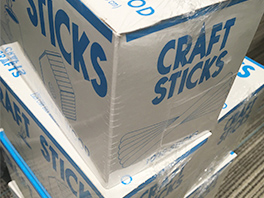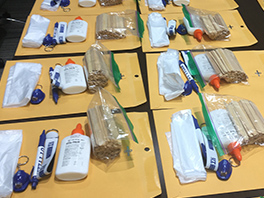Building Bridges
HEC Connects With Community Through Popsicle Bridge Contest
 The UT Tyler Houston Engineering Center serves as host of the most popular community outreach activity created out of the
partnership between the HEC and Alief Independent School District in Houston. This
year, HEC and district officials held the Alief Popsicle Bridge Competition contest
virtually with the largest group of registered teams – at 274 – in event history.
The UT Tyler Houston Engineering Center serves as host of the most popular community outreach activity created out of the
partnership between the HEC and Alief Independent School District in Houston. This
year, HEC and district officials held the Alief Popsicle Bridge Competition contest
virtually with the largest group of registered teams – at 274 – in event history.
Since 2018, the two-day contest highlights Alief ISD elementary, middle and high school students creating bridges out of standard craft sticks with certain build and support guidelines. Students attempt to build the strongest bridge with the fewest sticks possible. They are judged in age groups based on neatness, craftsmanship and creativity.
The event provides a unique way for Alief ISD students to interact with the HEC while learning basic engineering concepts, according to Dr. Andres Garcia, HEC director.
“Our intention was to create an activity that will engage all students at the school level, and simultaneously get all HEC students engaged in outreach activities,” Garcia said. “Alief students learn to build a bridge, follow competition rules, and most importantly, they experience a sense of belonging – while our HEC students learn to give back to the community, have a chance to accumulate service hours, and be part of a team.”
 Building upon the success of this event, Garcia said plans are to create a similar
K-12 inclusion competition in the fall focusing on wind turbine blades while highlighting
additional Science, Technology, Engineering and Mathematics (STEM) concepts and sustainable
energy discussions.
Building upon the success of this event, Garcia said plans are to create a similar
K-12 inclusion competition in the fall focusing on wind turbine blades while highlighting
additional Science, Technology, Engineering and Mathematics (STEM) concepts and sustainable
energy discussions.
“The importance can be categorized in various ways, but mainly it’s all about bonding our students, and generating a sense of service, community involvement and outreach by showing the next generation that they can easily be a STEM student, and that it can be fun,” he added.
For more information, or for UT Tyler HEC students interested in volunteering, contact Garcia at agarcia@uttyler.edu.
Special Segment: Did You Know?
Bridges have fascinated people since the dawn of time when nature itself built many bridges in the form of fallen trees over rivers or ancient icicle arches. As technology developed, people began to build artificial bridges. Advances in bridge design, engineering, and construction have made many types of bridges possible while utilizing numerous materials.
Today, bridges can be of the arch, beam action, cable stay, suspension or truss type. Materials used throughout history include wood, masonry, cast iron, wrought iron, concrete, steel, reinforced concrete, alloy and silicon steel, pre-stressed concrete, carbon fiber and aluminum.
#COE
Read more from the latest issue!




